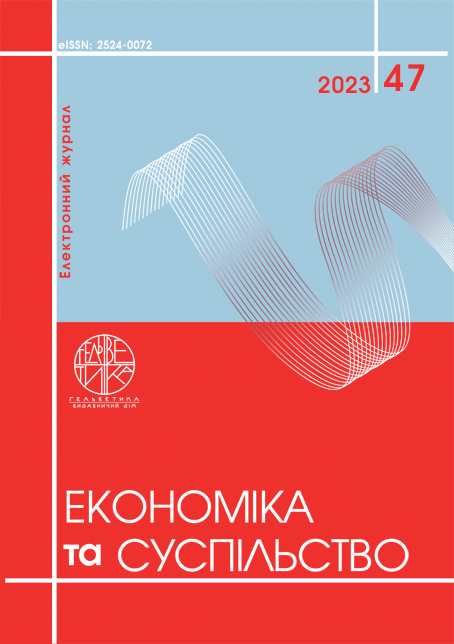MARKETING ECOSYSTEM IN CYBERSPORTS
Abstract
Esports is built around video games, which are a global and very popular form of entertainment. According to previous research, at least one person in 63% of US households plays video games for at least three hours per week, and 61% of eSports fans live in households with three or more people. According to the popular video game streaming platform Twitch, more than 100 million viewers watch eSports every month. This makes the business of eSports extremely relevant from a marketing point of view because the accumulation of a significant number of people in one place at the same time is a favorable environment for the promotion of various types of products and services (both endemic and non-endemic). The study of scientific literature in the field of eSports provides a weak general understanding of the marketing approach, which takes into account the structure of eSports from the perspective of the business environment, as well as the roles and dependencies between the key participants in this field. In this study, we define the eSports marketing ecosystem as a complex sociological, economic, and technical system capable of influencing the consumer decisions of all its participants. Such a system consists of human networks that generate productive output on a sustainable basis, and a business ecosystem consisting of interdependent firms that form symbiotic relationships to create and deliver products and services. That is why our task was to investigate the structure of the eSports environment from the point of view of its organization and involvement in business; as well as the peculiarities of the interaction of the participants of the marketing ecosystem, their interdependence, and value creation through cooperation in the marketing ecosystem of eSports. The validity of our research was enhanced by detailed data collection aimed at obtaining a deeper understanding of eSports phenomena from a marketing perspective based on primary data from interviews with eSports experts and secondary data from the analysis of a large amount of secondary data (industry reports, press releases, eSports columns, and blogs). We invited four experienced Ukrainian eSports experts for an interview. Using a reverse approach with primary and secondary data, we were able to ensure that all information based on the secondary data set was consistent with the expert interviews, and this guided our interviewee research. As part of this process, we asked our interviewees to describe the eSports environment, the participants in it, and the interactions between eSports partners as they understand them. Based on the preliminary analysis, we concluded that the direct participants of eSports competitions are interested in the entry of commercial companies into the sphere with the aim of additional financing by the method of sponsoring. This study identified a behavioral mechanism related to the need for interaction among all eSports players: game developers, sports teams, game platform developers, endermic product manufacturers, fan product manufacturers, and non-endemic product manufacturers. Thus, as a result of the survey of respondents, it was confirmed that we have achieved the main goal of our research. We determined the importance of the formation and development of the structure of the eSports environment from the point of view of its organization and involvement
References
Ambrasaitė, P., & Smagurauskaitė, A. (2021). Epic Games v. Apple: Fortnite battle that can change the industry. Vilnius University Open Series, (4), 6–25. DOI: https://doi.org/10.15388/tmp.2021.1
Bertschy, M., Mühlbacher, H., & Desbordes, M. (2019). Esports extension of a football brand: stakeholder co-creation in action? European Sport Management Quarterly, 20(1), 47–68. DOI: https://doi.org/10.1080/16184742.2019.1689281
Braun, V., & Clarke, V. (2006). Using thematic analysis in psychology. Qualitative Research in Psychology, 3(2), 77–101.
Chan, M. F., Lou, F., Zang, Y., Chung, Y. F., Wu, L. H., Cao, F., & Li, P. (2007). RETRACTED: Attitudes of midwives towards perinatal bereavement in Hong Kong. Midwifery, 23(3), 309–321. DOI: https://doi.org/10.1016/j.midw.2006.05.005
FIFA to hold eClub World Cup in Paris. (2019, July 20). Retrieved December 6, 2022, from www.fifa.gg website: https://www.fifa.com/fifaeworldcup/news/fifa-to-hold-eclub-world-cup-in-paris
Gawrysiak, J., Burton, R., Jenny, S., & Williams, D. (2020). Using Esports Efficiently to Enhance and Extend Brand Perceptions – A Literature Review. Physical Culture and Sport. Studies and Research, 0(0). DOI: https://doi.org/10.2478/pcssr-2020-0008
Seo (2011). A Comparative Study on the Interactivity of Paradise Now and StarCraft. English & American Cultural Studies, 11(2), 75–96. DOI: https://doi.org/10.15839/eacs.11.2.201108.75
Jenny, S. E., Keiper, M. C., Taylor, B. J., Williams, D. P., Gawrysiak, J., Manning, R. D., & Tutka, P. M. (2018). eSports Venues: A New Sport Business Opportunity. Journal of Applied Sport Management, 10(1), 34–49. DOI: https://doi.org/10.18666/jasm-2018-v10-i1-8469
Newzoo Global Esports Market Report 2020 | Light Version. (2022, October). Retrieved from Newzoo website: https://newzoo.com/insights/trend-reports/newzoo-global-esports-market-report-2020-light-version
Number of eSports viewers in the United States from 2018 to 2023. (2019, November 29). Retrieved November 20, 2022, from statista.com website: https://www.statista.com/statistics/694346/leading-ways-watching-esports-united-states/
Reitman, J. G., Anderson-Coto, M. J., Wu, M., Lee, J. S., & Steinkuehler, C. (2019). Esports Research: A Literature Review. Games and Culture, 15(1), 155541201984089. DOI: https://doi.org/10.1177/1555412019840892
Scholz, T. M. (2020). Deciphering the World of eSports. International Journal on Media Management, 22(1), 1–12. DOI: https://doi.org/10.1080/14241277.2020.1757808
Shin, J.-W., Koo, Y. S., Kim, Y.-S., Kim, D. W., Kim, K. K., Lee, S.-Y., … Lee, S. K. (2018). Clinical characterization of unknown/cryptogenic status epilepticus suspected as encephalitis: A multicenter cohort study. Journal of Neuroimmunology, 315, 1–8. DOI: https://doi.org/10.1016/j.jneuroim.2017.12.004
Sjjblom, M., & Hamari, J. (2016). Why Do People Watch Others Play Video Games? An Empirical Study on the Motivations of Twitch Users. SSRN Electronic Journal, 75. DOI: https://doi.org/10.2139/ssrn.2779543
Sjöblom, M., Macey, J., & Hamari, J. (2019). Digital athletics in analog stadiums. Internet Research, ahead-of-print(ahead-of-print). DOI: https://doi.org/10.1108/intr-07-2018-0304
Staff, S. (2018, December 17). League of Legends World Finals viewing figures 2018. Retrieved December 6, 2022, from Strive Sponsorship, UK website: https://strivesponsorship.com/2018/12/17/league-of-legends-world-finals-viewing-figures-2018
Steigenberger, N., & Scholz, T. M. (2022). Consequences of Umbrella Category Swaps: The Case of Esports. Academy of Management Proceedings, 2022(1). DOI: https://doi.org/10.5465/ambpp.2022.14252abstract
Wijman, T. (2022, November). Video Games, Esports & Mobile Intelligence | Insights and Articles. Retrieved from Newzoo website: https://newzoo.com/insights/articles


